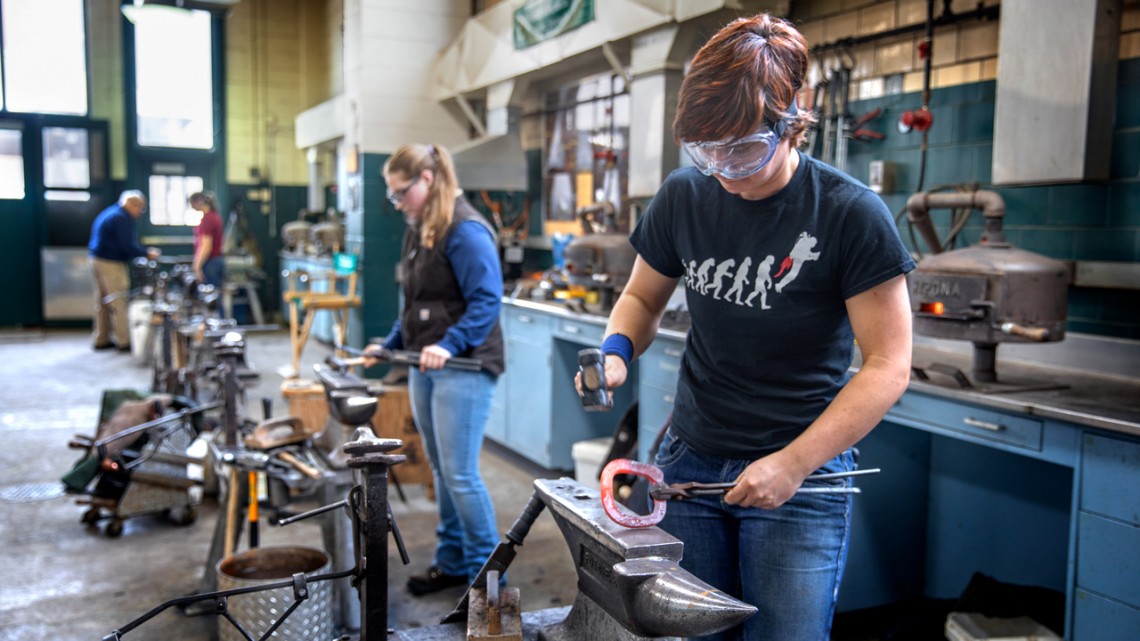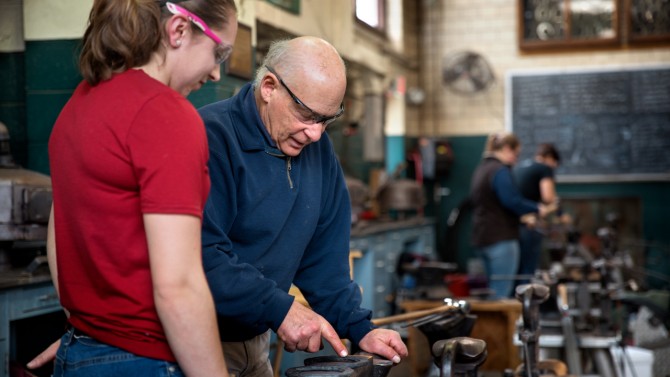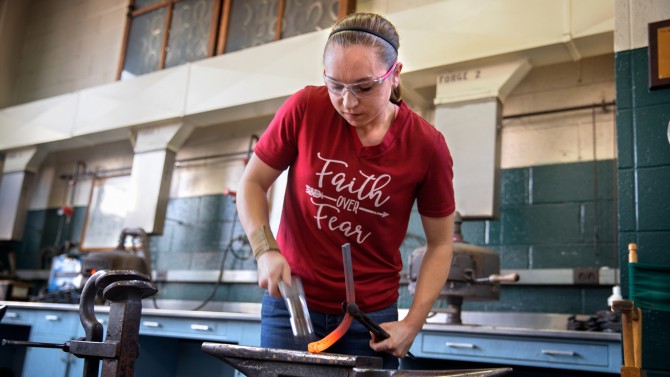
Kerry Spain, right, and Kahlan Schramm shape horseshoes as part of the Cornell Farrier Program.
Cornell farrier program admits first all-female cohort
By Melanie Greaver Cordova
After more than 100 years in existence, the Cornell Farrier Program has admitted its first all-women class. In early January, three women walked through the farrier shop doors, started up the forge and got to work.
Paige Maxxam, Kahlan Schramm and Kerry Spain will complete the program in April and use their training to enter as apprentices into a field where skilled workers are in high demand. “I had people back home asking me to work on their horse as soon as they found out I was coming to Cornell,” says Schramm of North Bennington, Vermont.
The shop is a place of extremes this time of year. Wind and snow clap at doors wide enough to lead a horse through while fire in the forge warms anyone within four feet. The students hold tongs carefully against giant anvils as the ring of hammers echoes against walls filled with tools. Overseeing this work is Steven Kraus ’70, head of farrier services and senior lecturer in the College of Veterinary Medicine, who demonstrates crafting a hoof pick for his students and then walks between them as they emulate his work.
“More and more women want to get involved in horseshoeing,” says Kraus, who has been shoeing horses for more than 50 years and leading the program for the last eight. “It’s the same trend you see in veterinary medicine in general.”
The number of women in veterinary medicine has grown substantially in the last 100 years. Enrollment in the Doctor of Veterinary Medicine (DVM) program at the College of Veterinary Medicine saw a roughly even gender split for the first time in 1979, and women have increasingly outnumbered men since 1980. The fall 2017 entering DVM class was 83 percent female, with 100 women and 21 men. This growing trend extends to farriery, where currently fewer than 10 percent of the industry is female.
“It’s empowering,” says Spain, who came to Ithaca from Rutland, Vermont. “We’re breaking a glass ceiling.”
Undercover farrier
Kraus has seen the numbers rise at Cornell since arriving as an undergraduate in 1968. He was there when the first woman, Toni Hanna, entered the farrier program in 1972. “She actually disguised herself when she came in for an interview,” he says.
Hanna knew that Harold Mowers, the farrier at that time, would reject her immediately despite her background and professional recommendations, so she hid her hair under a hat and wrapped her midsection with an ACE bandage.
“Harold said that a woman can shoe a horse but a lady can’t,” says Kraus, who recalls Mowers declaring he would resign if he had to teach a woman. “But within that first week, they were best friends,” he says.
Farrier work can be demanding, complicated and sometimes dangerous. Students must have a background in horses to be considered for the program, although most do not come with previous forge experience. When it comes to the animals, even if they’ve been around horses all their lives, being beneath a horse is much different. “It’s pretty intense,” says Maxxam. “You have to be able to do that without hurting the horse or hurting yourself.”
Partnering with the Equine Hospital
The program celebrated its centennial in 2014. As one of the only courses in the United States connected to a veterinary teaching hospital, the admissions process is more selective. Most competitors are either privately owned or part of smaller community colleges.
“We want there to be a focus on one-on-one learning. Four students is the max,” says Kraus.
While the curriculum starts with the basics – emphasizing body position and techniques before moving to more advanced instruction – partnership with the college’s Equine Hospital adds a certain amount of unpredictability. If an equine patient has a more complex condition than what the students have learned to work with so far, they are still expected to learn from the situation and be ready to assist.
“It’s great getting that experience. I’d never seen radiographs with my trimmings before,” says Schramm, referencing hooves she had trimmed with the various knives, nippers and rasps of the trade.
“The students have to be flexible, but they get to see cases they wouldn’t otherwise experience,” says Kraus.
Serving the public
Most often, Cornell farrier students are not simultaneously enrolled in the university, and typically travel to Ithaca from all over the country to participate. The course, developed in 1913 to produce farriers who help the public, is offered concurrently with the semester and runs for 16 weeks. “The training for farriers at that time was nonexistent, and now it’s part of the mandate from New York,” says Kraus.
This mandate is part of the university’s land-grant foundation. In 1862, President Abraham Lincoln gave federal land to each state that could be sold to build and operate a college. Three years later, state senators Andrew Dixon White and Ezra Cornell won passage of a bill that established Cornell University as New York’s land-grant educational institution. The university is dedicated to the larger goals of providing scientific and technical education alongside studies in history and literature. This extends to industry training like farriery that benefits residents of New York and beyond.
“I’m here because I want to pursue this dream,” says Maxxam, who is from Brant Lake, New York. When the course finishes, most students find apprenticeships with their hometown farriers, which is Maxxam’s goal.
They will enter a promising job market when graduated, since an accomplished, well-trained farrier horse owners trust can be hard to find, says Spain. “The horse community is small but the farrier community is even smaller,” she says.
Supporting equine welfare
In addition to providing future farriers with practical skills and helping Cornell achieve its land-grant mission, the farrier program at its most basic level simply helps keep horses healthy, says Kraus. “The proper training for farriers will help them do things right and keep the horses from suffering,” he says.
According to the American Horse Council, there are approximately 9.2 million horses in the United States. While farriers are typically seen working on hooves, they also often forge and fit horseshoes from scratch, and then work to ensure the proper trim. A key part of a farrier’s job is examining the anatomy of a horse. A farrier cannot change the animal’s body if something is amiss, but they can manage the hoof capsule to ensure the horse remains balanced and aligned. Proper farrier work helps avoid lameness and other injuries that can shorten the horse’s lifespan.
“It’s very comprehensive,” says Maxxam. “You look at the whole horse.”
The course will test the students according to criteria developed by the American Farriers Association (AFA). Kraus has served as an examiner for the AFA certification exams and was one of the first people to be certified at the highest level. He encourages all of his students to take the AFA exam, even though it’s voluntary.
“It’s a consumer protection issue and an equine welfare issue,” he says.
The program also draws professional farriers who take its intensive week-long continuing education sessions. They come to hone their knowledge and learn new skills, such as working with glue-on shoes, in a shop that is internationally recognized for providing an important service to the industry. “People come here for honest answers,” says Kraus, who became Cornell’s resident farrier in 2010, bringing with him a revamped curriculum that included more time with horses.
Justin Dean, a professional farrier from Florida, traveled to Ithaca during a snowstorm just to work with Kraus. Dean has been a farrier for more than 10 years and trained for a week in February as part of his professional commitment to staying current. “Somebody who knows what they’re doing can really help a horse live better and longer,” he says. “You can take a lame horse and make them sound again.”
Few farriers and even fewer women
Interest in the welfare of horses is what drew the three women to the industry to begin with, and it’s why they’re willing to undergo a grueling 16-week course to get their start. “I always was fascinated by how much a farrier could help you and your horse,” says Schramm. “Every little change can be helpful.”
There are fewer than 3,000 female farriers in the United States, but as the students confidently work the forge or survey a horse in the shop, it’s clear none of them have second thoughts about entering into a male-dominated profession like farriery. They’re more concerned with learning the skills to succeed. “It doesn’t faze me at all,” says Maxxam. “The work is just what I do.”
“It’s not about being a woman or a man,” adds Schramm. “You need to be good at your job first. That’s why we’re here.”
Melanie Greaver Cordova is a staff writer with the College of Veterinary Medicine.
Media Contact
Get Cornell news delivered right to your inbox.
Subscribe


